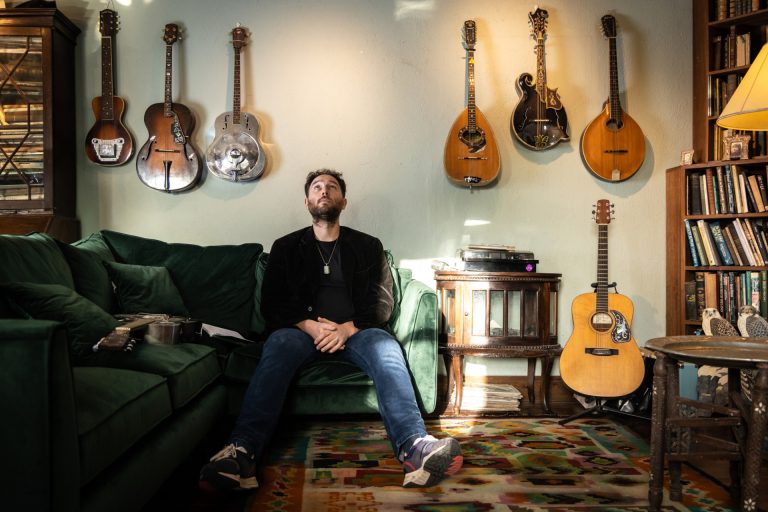Cian Finn has spent his career as a pioneering spirit for Irish reggae, a distinctive voice delivering a sonically unlimited mix of reggae, dub, hip-hop, electronica and traditional music. After touring worldwide and collaborating with a huge range of musicians, his latest album What’s Next, brings both versatility and creative depth, a return to introspective themes as he looks ahead to the future. With that project now making its impact in the world, we asked Cian what that new future looks like…
To start us off, you’ve described What’s Next as a ‘snapshot of the present, for the future.’ What, in your opinion, makes giving projects like these a sonic timestamp so important?
For me, capturing the present moment with a sonic timestamp is vital because it gives music the power to reflect pivotal times, much like Bob Dylan’s Masters of War or traditional Irish folk tunes that encapsulate historical moments. This approach makes songs feel like conversations with the past, where messages are embedded in metaphor and wisdom. For What’s Next, I wanted the album to serve as a time capsule. Songs touch on significant issues, like the opening and closing with Middle Eastern themes, including a collaboration with Palestinian-Irish artist Róisín Al Sharaif. This grounding in the present allows the album to remain contextually relevant even decades from now.
You’ve mentioned that tracks like ‘Grá Mór’ and ‘All I Wanna Do’ reflect on growing up in Galway. Are there any specific experiences or memories that helped to shape these tracks, and how do they tie into the broader themes of the album?
Grá Mór and All I Wanna Do are nostalgic reflections, loaded with memories of Galway life. All I Wanna Do recalls wild nights, familiar spots like the Spanish Arch, and the camaraderie of youth. Grá Mór, on the other hand, is more reflective, a tribute to the people who shaped me—friends, community members, and family. These tracks tie into the album’s broader theme of retrospection, tracing the personal journey and cultural influences that brought me to this point in my life and music career.
It’s been almost a decade since your debut album, This Applies, was released. How would you say your sound and art have evolved, now that you’re arriving at the release of What’s Next?
This Applies was my attempt at recreating a classic 1970s reggae album, heavily influenced by Jamaican reggae from Studio One. Over the years, my music has absorbed and reflected diverse influences—traditional Irish, soul, Motown, hip-hop, reggae, and drum & bass. Each album I create introduces new elements, so What’s Next isn’t just reggae or folk; it’s a fusion of everything I’ve absorbed. Going forward, I’m planning projects that stretch across genres—liquid drum & bass, a stripped-back acoustic folk album, and even a Motown-style soul album. My sound evolves based on my current inspirations, adding to the musical legacy I’m crafting.
As the head of Emerald Isle Records, how has running the business side of your music influenced your creative process, and what goals do you have for the label moving forward?
Emerald Isle Records started as a DIY project, inspired by Mungo’s Hi-Fi. It was crucial for me to understand every element of music production, so I handled everything myself, from tracking down producers to managing art. Initially, I planned to use the label to elevate other Irish artists, but it ended up focusing on my work. Moving forward, my goal is to streamline and focus on producing music in my studio, with the hope of eventually featuring other Irish acts. I’ve learned that balancing the label and my creative pursuits can spread me thin, so this shift allows me to focus fully on my music, with the option to expand if the timing is right.
Finally, you’re someone who has been consistently innovating within the Irish music scene. What trends or changes do you see emerging in Irish reggae or hip-hop, and how do you envision your role within that evolving landscape?
Irish reggae is currently low-key, unlike the past when sound system culture was thriving across Ireland. These days, Irish hip-hop is really coming into its own, particularly with strong contributions from Limerick and Dublin, fueled by a renewed creative confidence. This evolution feels natural, as Ireland has a rich tradition of spoken word and storytelling. I see myself contributing by creating music rooted in Galway culture, such as my track All I Wanna Do, which captures the city’s essence. Ultimately, my role is to add to Ireland’s musical heritage, leaving behind a body of work that future generations might connect with, much like the music that inspired me.
